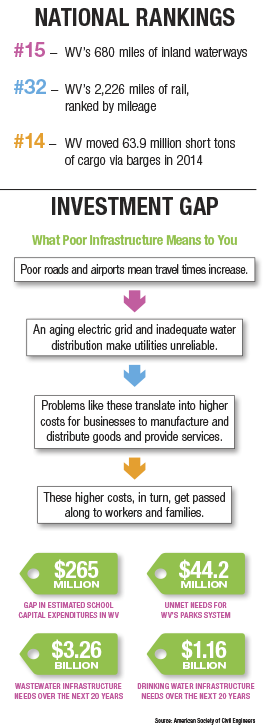 The dire condition of infrastructure today is a major challenge not only for the state of West Virginia but for the U.S. as a whole. Last year, the American Society of Civil Engineers (ASCE) Committee on American Infrastructure published the 2017 Infrastructure Report Card, ranking the U.S. based on the following key criteria: capacity, condition, funding, future need, operation and maintenance, public safety, resilience and innovation. The U.S. earned a D+, which means that nationwide our infrastructure is in poor condition, showing signs of significant deterioration with a strong risk of failure.
The dire condition of infrastructure today is a major challenge not only for the state of West Virginia but for the U.S. as a whole. Last year, the American Society of Civil Engineers (ASCE) Committee on American Infrastructure published the 2017 Infrastructure Report Card, ranking the U.S. based on the following key criteria: capacity, condition, funding, future need, operation and maintenance, public safety, resilience and innovation. The U.S. earned a D+, which means that nationwide our infrastructure is in poor condition, showing signs of significant deterioration with a strong risk of failure.
As part of the 2017 report card, the ASCE also prepared state and regional reports highlighting strengths and weaknesses in each state. While West Virginia was not given a letter grade, based on the state’s report it is clear that West Virginia’s infrastructure is as much of an issue as national infrastructure.
For example, findings from 2017 show drinking water-related needs in West Virginia are estimated at $1.16 billion, and wastewater-related needs total $3.26 billion. There are 285 dams that are considered to have high-hazard potential and 10 sites on the National Priorities List for their release or threatened release of hazardous substances, pollutants or contaminants. The state’s schools have an estimated capital expenditure gap of $265 million, and the parks system is sitting at $44.2 million in unmet needs.
While no reports have been created for the year 2018, last year’s reporting is an eye-opening revelation on the challenges our communities, businesses and transportation modes will continue to face unless these conditions are addressed.
Because we can’t address our challenges—and identify opportunities for economic growth—unless we know where we currently stand, here West Virginia Executive reviews some key facts about the Mountain State’s infrastructure.
To learn more about the 2017 Infrastructure Report Card and view the full report as well as recommendations for key solutions and game-changing factors, visit www.infrastructurereportcard.org.











